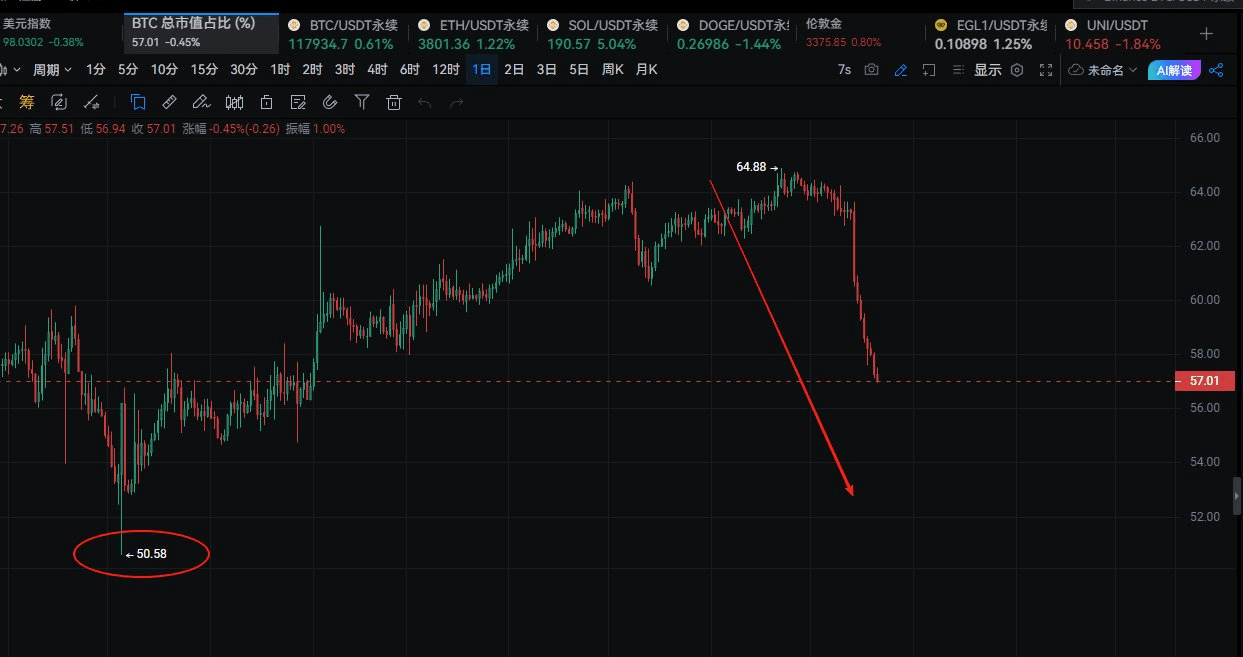 Recently, I have been closely monitoring Bitcoin's market cap dominance, which has dropped rapidly these past few days. At the previous low of 50, in December 2024, it was essentially the peak for altcoins, indicating that while Bitcoin's market cap dominance is falling, it can be understood as capital flowing out, possibly signaling the arrival of altcoin season.
Recently, I have been closely monitoring Bitcoin's market cap dominance, which has dropped rapidly these past few days. At the previous low of 50, in December 2024, it was essentially the peak for altcoins, indicating that while Bitcoin's market cap dominance is falling, it can be understood as capital flowing out, possibly signaling the arrival of altcoin season.
The rapid decline in Bitcoin's market capitalization dominance usually reflects some important dynamics in the cryptocurrency market. Here are some possible reasons and implications:
1. Funds flowing into altcoins
- A decline in Bitcoin's market capitalization dominance usually means that funds are flowing from Bitcoin to other cryptocurrencies (altcoins), especially mainstream altcoins like Ethereum (ETH), Solana (SOL), or other emerging tokens. This phenomenon typically occurs when market sentiment is high and investors have an increased risk appetite.
This may signal the arrival of 'altcoin season', where investors are more inclined to invest in high-risk, high-return altcoin projects, especially during a bull market.
2. Changes in market sentiment and risk appetite
- Bitcoin is viewed as a 'safe-haven asset' in the crypto market, similar to 'digital gold.' When Bitcoin's market cap dominance declines rapidly, it indicates that investors are gaining confidence in the market, willing to take on more risk and invest in more speculative altcoins. This usually happens in the late stages of a bull market, as investors chase high-growth opportunities, leading to rapid increases in altcoin prices.
3. The attractiveness of new technologies and projects
- Innovations in altcoins (such as Ethereum's smart contracts, Cardano's scientific blockchain, Polkadot's cross-chain technology, etc.) have attracted a significant inflow of funds, leading to the dilution of Bitcoin's market share.
The market is becoming more diversified, and Bitcoin's dominance may weaken due to competition from emerging technologies. This is seen by some as a sign of the maturation of the crypto market.
4. External economic or regulatory factors
- Macroeconomic conditions (such as interest rate changes, inflation) or regulatory policies may lead to decreased investor confidence in Bitcoin, prompting them to invest in other assets.
If the decline is related to negative news (such as regulatory pressure), it may be a temporary shift in market risk sentiment; if related to innovative projects, it reflects the market's pursuit of new opportunities.
5. The impact of stablecoins
- The growth of market share for stablecoins (such as USDT, USDC) can dilute Bitcoin's market cap dominance because these assets are included in the total market capitalization, but their functions differ from speculative cryptocurrencies.
The decline in Bitcoin's market capitalization dominance may not completely reflect a decrease in Bitcoin's value but rather changes in market structure, requiring analysis alongside other indicators (such as trading volume, actual liquidity).
6. Historical trends and current data
- Historical context: Bitcoin's market cap dominance fell from 85% to 37% during the ICO boom in 2017, and again significantly decreased in 2021 due to the DeFi and NFT boom. In 2024, Bitcoin's dominance fluctuated between 52% and 61%, and as of July 2025, the latest data shows Bitcoin's dominance at approximately 59.13%.
Recently, Bitcoin's market cap dominance has dropped from 64% to 57.45%, with funds primarily flowing into ETH and other altcoins, indicating that the market may be entering an active altcoin phase.
7. Insights for investors
- The decline in Bitcoin's market cap dominance may suggest investors pay attention to investment opportunities in altcoins, especially those with innovative technologies or community support.
A rapid decline may be accompanied by increased market volatility, and investors need to be cautious of the high-risk characteristics of altcoins, avoiding blind investments driven by FOMO.
Note:
- Bitcoin's market capitalization dominance is not an all-encompassing indicator; stablecoins and 'dead coins' (tokens with no active trading) may distort the data. Real market dynamics need to be analyzed alongside trading volume, on-chain data (such as Glassnode's Hot Supply indicator), and more.
Although the decline may signal the arrival of altcoin season, market sentiment can change rapidly, necessitating attention to macroeconomic factors, policy changes, and other external factors.
Final summary:
- A rapid decline in Bitcoin's market capitalization dominance usually reflects funds flowing from Bitcoin to altcoins, which may be the result of the market entering a high-risk appetite phase, the late stage of a bull market, or new projects attracting capital. This may signal the arrival of altcoin season but also comes with higher volatility and risk. Investors should cautiously develop strategies by combining other indicators (such as trading volume, on-chain data) and market context.
